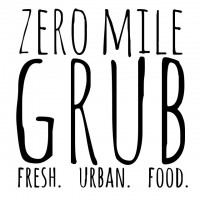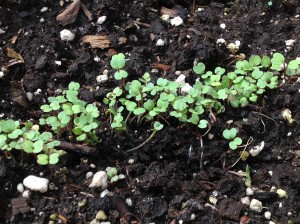Starting your plants from seed has several advantages. First, it’s cheaper than buying small plants from your local nursery. Second, you can find a much wider variety of types of seeds than you can seedlings. Third, it’s fun and satisfying to know that you grew your veggies from start to finish!
In order to start your plants from seed, there are some things you need to consider.
- Should you start the seeds indoors early, or outdoors when the weather has warmed up?
- Indoors or out, when do you start? When do you transplant?
- Are there special requirements that the seed needs?
Indoors vs. Outdoors
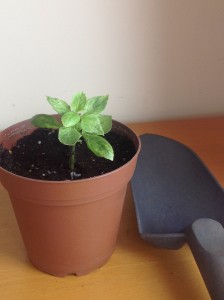 Some plants do not like to be transplanted. Root vegetables, in particular, fall into this category. Don’t be lured into buying starter plants of, say, carrots, because they will likely sulk in the ground, and may not produce anything useful. Instead, they should be started from seed directly in the ground.
Some plants do not like to be transplanted. Root vegetables, in particular, fall into this category. Don’t be lured into buying starter plants of, say, carrots, because they will likely sulk in the ground, and may not produce anything useful. Instead, they should be started from seed directly in the ground.
Other seeds can theoretically be started outdoors, but either need really warm soil to germinate (eg. tomatoes), or have such a long maturity date (eg. onions) that the plants will not have time to produce a crop before the cool weather of fall begins. These seeds should be started indoors, as a way of starting the “summer” early. This is a great time to use the origami pots you made!
Finally, there are seeds that are often started outdoors, but, based on experience you find it worthwhile to start indoors. For example, quinoa sprouts quickly and easily, and does not need particularly warm weather, so
it should be ideal to start outside. However there is a weed (lamb’s quarters) that is common in our region and
looks very much like quinoa, especially when the plant is small. This makes it difficult to know which plant to pull and which plant to keep, so I find it makes more sense to transplant quinoa when it is large enough that I know for sure it is not the weed.
Timing
In order to know when to start planting, you need to know a bit about the average spring temperatures in your area. The most important thing to know is your first frost-free date. This is defined as the first date when the risk of frost drops below 50%. In the Toronto area, this date is May 9th. However, there can be microclimates, so you may need to adjust your specific date a bit. For example, our garden is close to Lake Ontario. Since the lake warms up more slowly than the surrounding land, it throws of cool air in the spring, and our garden temperatures are a few degrees lower than they are inland. (Happily, the converse is true in the fall, and the lake effect makes our garden slightly warmer than places further from the lake.)
There are many resources you can use to help you determine your first frost-free date. For example, here is one for major cities in Canada and here for the US. It can also be helpful to speak to gardeners in your area.
Seed starting and transplanting guidelines are usually given in terms of frost-free dates. For example, tomato seeds are usually started 4-5 weeks before your frost-free date, and the seedlings are transplanted into the garden 2 weeks after the frost-free date, making the transplants 6-7 weeks old. You can usually find this information on the seed package, but some general guidelines are also provided here.
Special requirements
Some seeds require particular conditions in order to germinate. The most common special requirement is temperature. For example, tomatoes germinate best when the temperature is between 20˚C and 27˚C Peppers need warmer temperatures, and eggplants need warmer still. It is common to use the top of the fridge as a germination space, since it tends to be one of the most consistently warm places in the house. In our case, however, we can’t access this space since our fridge is enclosed in cabinets. Instead, we bought a special heating mat that is specifically made for germinating seeds, and increases the surrounding temperature by approximately 5˚C over room temperature.
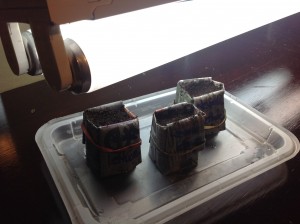 Most vegetable seeds do not require light to germinate, just moisture (and possibly heat). There are a few exceptions to this. Many lettuce seeds need light, and celeriac needs light as well. If your seed has a light requirement, it should be marked on the package. In this case, do not cover the seeds with soil, but instead press them firmly onto the surface of the soil. You might want to spray the top with water, instead of traditional watering, so that you don’t accidentally wash the seeds away. It is important to keep the seeds moist. Since the seeds are exposed to light, the water will evaporate more quickly than seeds in the dark.
Most vegetable seeds do not require light to germinate, just moisture (and possibly heat). There are a few exceptions to this. Many lettuce seeds need light, and celeriac needs light as well. If your seed has a light requirement, it should be marked on the package. In this case, do not cover the seeds with soil, but instead press them firmly onto the surface of the soil. You might want to spray the top with water, instead of traditional watering, so that you don’t accidentally wash the seeds away. It is important to keep the seeds moist. Since the seeds are exposed to light, the water will evaporate more quickly than seeds in the dark.
Then there are some fussy seeds that need both a combination of light and temperature changes to germinate. These divas are usually flowers. The most notable one that I have come across is the poppy, which requires both a cold period and darkness, and then warmth before it germinates. These seeds are usually planted in the fall, so that the winter snow keeps the seeds cold and dark until spring.
Bulbs and sets
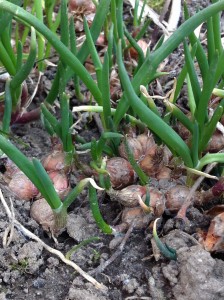 A few vegetables are grown from bulbs or sets. These include garlic, shallots and walking onions. Regular cooking onions can be started from either seeds or sets. Garlic, shallots and walking onions can survive the winter (Toronto winters, anyway), and are usually planted in the fall. Although you can do this anytime in the fall, I tend to wait until early November – if I do it sooner, the squirrels usually dig everything up in their fall preparation madness. Although these plants can also be planted in the spring, fall planting will allow them to start growing in the spring as soon as the weather is warm enough, resulting in earlier maturity, as well as higher (or larger) yields.
A few vegetables are grown from bulbs or sets. These include garlic, shallots and walking onions. Regular cooking onions can be started from either seeds or sets. Garlic, shallots and walking onions can survive the winter (Toronto winters, anyway), and are usually planted in the fall. Although you can do this anytime in the fall, I tend to wait until early November – if I do it sooner, the squirrels usually dig everything up in their fall preparation madness. Although these plants can also be planted in the spring, fall planting will allow them to start growing in the spring as soon as the weather is warm enough, resulting in earlier maturity, as well as higher (or larger) yields.
Cooking onions are more sensitive to the cold, and, if you are starting them from sets, should be planted in the spring, as soon as the weather warms up enough to work the soil.
